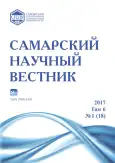Snow cover and the climate severity influence on the common fox (Vulpes vulpes) behavioral adaptation
- Authors: Skluev V.V.1, Sklueva O.A.1
-
Affiliations:
- Samara State Regional Academy (Nayanova)
- Issue: Vol 6, No 1 (2017)
- Pages: 72-77
- Section: 03.02.00 – General Biology
- URL: https://journals.rcsi.science/2309-4370/article/view/21644
- DOI: https://doi.org/10.17816/snv201761113
- ID: 21644
Cite item
Full Text
Abstract
One of the ways to adapt to the changing parameters of the environment is behavioral adaptation. The paper presents data on the weather rigidity index use (G. Bodman) in environmental studies. The authors describe the behavioral characteristics of the common fox (Vulpes vulpes, Linnaeus, 1758) activity depending on the amount of snow cover and the climate severity in Krasnoarmeyskiy district of the Samara Region. Relatively low temperature and quite high wind speed influence the heat loss of the animal more than high temperature in calm weather. In scientific literature (A.N. Formozov, 1946, 1990) it’s noted that it is possible to use «weather cruelty» indicator that defines the conditions that contribute to frostbite. It is determined by low air temperature and wind velocity that particularly affect cooling objects that have excessive heat in comparison with the environment. However, A.N. Formozov could not use this indicator due to rather large deviations as the wind speed and the temperature on the investigated territory, as even in the same locality there is a discrepancy with the data of weather stations located remotely from each other, this author didn’t study habitats independently (A.N. Formozov, 1946, 1990, 2010). At the same time it is also noted that snowfall is an important factor, a powerful element of the environment that indicates what life forms can live in vast areas with snowy winter. Snow cover leads to seasonal migration or switching to food located above the snow.
Full Text
##article.viewOnOriginalSite##About the authors
Valerij Vitaljevich Skluev
Samara State Regional Academy (Nayanova)
Author for correspondence.
Email: vvskl84@mail.ru
candidate of biological sciences, dean of Chemistry and Biology Faculty
Russian Federation, SamaraOlga Aleksandrovna Sklueva
Samara State Regional Academy (Nayanova)
Email: vvskl84@mail.ru
postgraduate student of Ecology and Environmental Protection Department
Russian Federation, SamaraReferences
- Формозов А.Н. Снежный покров как фактор среды, его значение в жизни млекопитающих и птиц СССР. М.: Изд-во МОИП, 1946. 152 с.
- Формозов А.Н. Снежный покров как фактор среды, его значение в жизни млекопитающих и птиц СССР / отв. ред. Е.Н. Матюшкин. 2-е изд. М.: Изд-во МГУ, 1990. 287 с.
- Формозов А.Н. Снежный покров в жизни млекопитающих и птиц. изд. 3. М.: Изд-во ЛКМ, 2010. 288 с.
- Склюев В.В. Популяционный анализ лисицы обыкновенной (Vulpes vulpes) в биотопах Самарской области разной степени нарушенности: Дис. … канд. биол. наук. Самара. 2010. 220 с.
- Мозговой Д.П. Информационно-знаковые поля млекопитающих: теория и практика полевых исследований: дис. в форме научного доклада. Самара: Универс-групп, 2005. 50 с.
- Мозговой Д.П., Розенберг Г.С. Сигнальное биологическое поле млекопитающих: теория и практика полевых исследований. Самара: Самарский ун-т, 1992. 119 с.
- Мозговой Д.П. Экологические особенности популяций млекопитающих и организация учетов численности // Всесоюзное совещание по проблеме кадастра и учета животного мира. Уфа, АН СССР, 1989. С. 327–328.
- Формозов А.Н. Спутник следопыта. М.: Изд-во МГУ, 1989. 320 с.
- Справка об ожидаемом характере весеннего половодья 2010 года на реках Российской Федерации и предварительный прогноз притока воды в крупные водохранилища во втором квартале [Электронный ресурс] // http://meteoinfo.ru/hydro-spring.
- ВолгаИнформ. В Самарской области готовятся к сильному половодью [Электронный ресурс] // http://volgainform.ru/allnews/430801.
- Исаева М.В. Пространственно-временная изменчивость основных биоклиматических показателей на территории Приволжского федерального округа: автореф. дис. … канд. геогр. наук. Казань, 2009. С. 14–22.
- Склюев В.В., Мозговой Д.П. Особенности поведения и динамика численности лисицы обыкновенной (Vulpes vulpes) в Красноармейском районе Самарской области // Вестник Самар. ГУ. Естественнонаучная серия. 2009. № 2 (68). С. 161–166.
- Склюев В.В. Особенности перекрывания участков лисицы обыкновенной, существенные при картировании территории // Современные проблемы зоологии позвоночных и паразитологии: мат-лы 3 междунар. науч. конф. «Чтения памяти проф. И.И. Барабаш-Никифорова», г. Воронеж, 20–21 марта 2011 г. Воронеж, 2011. С. 288–291.
- Склюев В.В. Полоспецифичные различия в площадях и размещении индивидуальных участков лисицы обыкновенной // Современные проблемы зоологии позвоночных и паразитологии: мат-лы 4 междунар. науч. конф. «Чтения памяти проф. И.И. Барабаш-Никифорова», г. Воронеж, 13–15 апр. 2012 г. Воронеж, 2012. С. 254–257.
- Склюев В.В. Избыточность кормовой базы как причина уменьшения площадей индивидуальных участков лисицы обыкновенной // Экология, эволюция и систематика животных: мат-лы междунар. науч.-практ. конф. Рязань, 2012. С. 370–372.
- Барановская Т.Н., Колосов А.М. Питание лисицы // Зоол. журн. 1935. Т. XIV, вып. 3. С. 523–550.
- Склюев В.В. Исследование состояния популяции лисицы Красноармейского района Самарской области // Изв. Самар. НЦ РАН. 2009. Т. 11, № 1(4). С. 661–665.
Supplementary files









